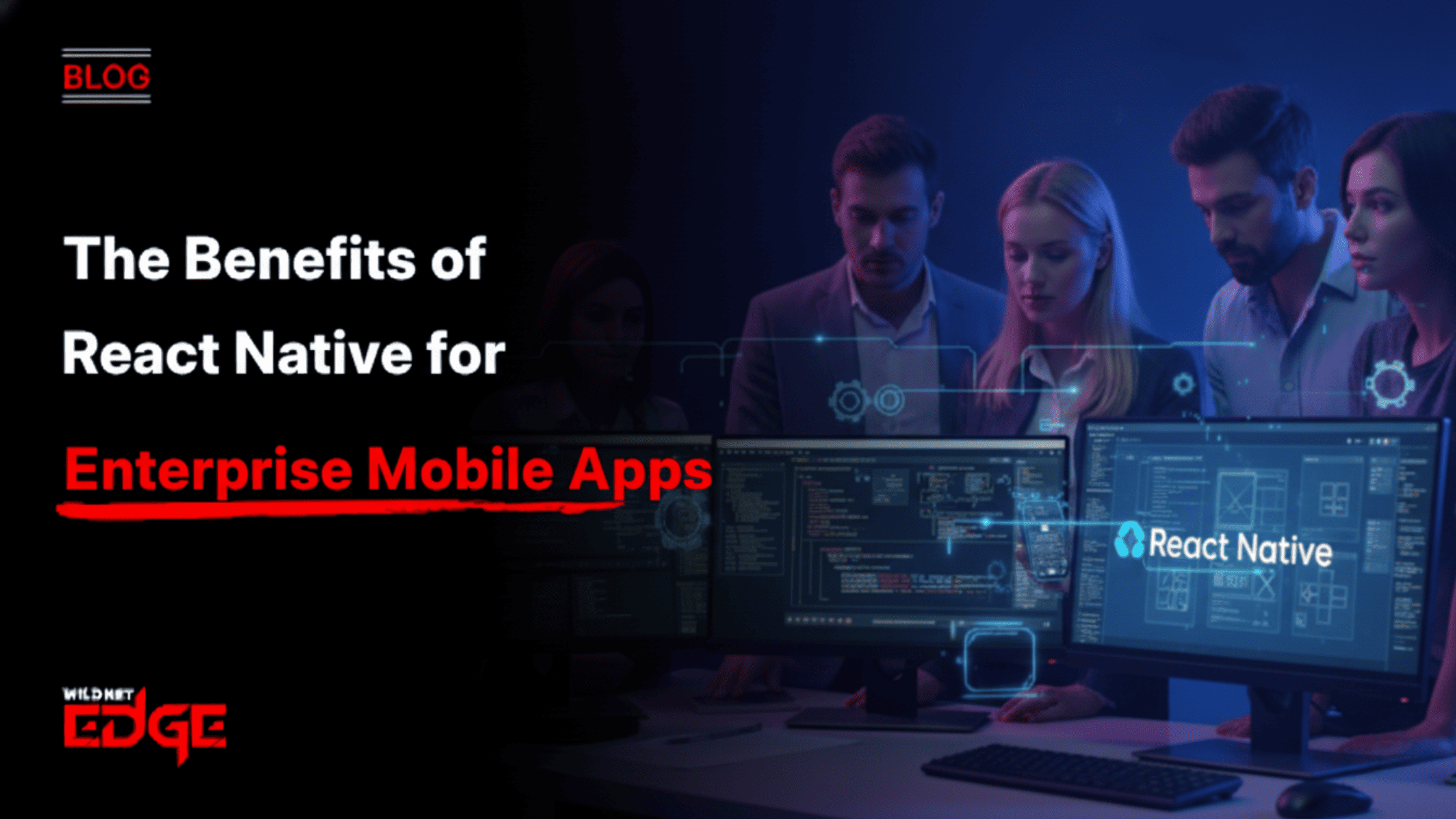TL;DR
This article explores why React Native is a compelling choice for enterprise mobile application development. It explains that the framework allows large organisations to build high-quality apps for both iOS and Android using a single JavaScript codebase, driving significant cost and time savings. The guide highlights key benefits relevant to enterprises, including faster time-to-market, easier maintenance through code reuse, and impressive cross-platform scalability. While acknowledging potential limitations for highly complex tasks, it presents React Native as a strategic tool for developing a wide range of enterprise mobile solutions efficiently, enabling businesses to reach their entire user base faster and more cost-effectively.
Large enterprises face unique challenges when it comes to mobile app development. They often need to support a vast user base across multiple platforms like iOS and Android, integrate with complex backend systems, and maintain rigorous security standards, all while managing significant development budgets. In this demanding environment, finding a technology that offers both efficiency and quality is paramount. This is where React Native for enterprises emerges as a powerful and strategic solution.
What is React Native?
React Native is an open-source framework developed by Facebook that enables developers to build natively rendering mobile applications for iOS and Android using the popular JavaScript library, React. Unlike traditional hybrid frameworks that run inside a web view, React Native uses native UI components, resulting in apps that look, feel, and perform much closer to fully native applications. Its core principle is “learn once, write anywhere,” allowing a single team to target multiple platforms with one codebase.
Why React Native Makes Sense for Enterprises
While often associated with startups for its speed, the benefits of React Native for enterprises are equally compelling, particularly when dealing with large-scale projects and diverse user needs.
Significant Cost and Time Savings
Developing and maintaining separate native apps for iOS and Android requires investment in distinct teams, codebases, and testing processes. React Native allows enterprises to leverage a single JavaScript codebase and often a single development team to target both platforms.
This code reuse can lead to significant reductions in development time and overall project costs, freeing up valuable resources for other strategic initiatives. This efficiency is a major driver for adopting enterprise mobile solutions.
Faster Time-to-Market Across Platforms
In competitive enterprise markets, being first with a new mobile feature or service can be a significant advantage. The ability to write code once and deploy it simultaneously to both iOS and Android drastically accelerates the development lifecycle. This allows large organisations to roll out new features and updates to their entire mobile user base much faster than with separate native development tracks.
Leveraging Existing Web Development Talent
Many enterprises already have significant in-house expertise in JavaScript and React for their web applications. React Native allows these organisations to leverage their existing talent pool to build mobile applications. This reduces the need to hire specialised (and often expensive) native iOS or Android developers, making it easier to staff projects and manage resources effectively. This makes working with a React Native App Development Company a potentially smoother transition.
Simplified Maintenance and Code Consistency
Managing updates and bug fixes across two separate native codebases is complex and time-consuming. With React Native, updates can often be made once in the shared codebase and deployed to both platforms. This simplifies the maintenance process, reduces the risk of inconsistencies between the iOS and Android versions, and ensures a more uniform user experience.
React Native vs. Native for Enterprise Apps: Key Considerations
While React Native offers many advantages, it’s important to understand the trade-offs compared to fully native development.
| Feature | React Native | Native (iOS/Android) |
| Development Cost | Lower | Higher |
| Time-to-Market | Faster | Slower |
| Codebase | Mostly Single | Separate |
| Performance | Near-Native | Highest Possible |
| Access to Native APIs | Good (via bridges), but can lag | Immediate & Full |
| Ideal Enterprise Use Cases | Internal tools, customer apps, eCommerce, content apps | CPU-intensive apps, complex background tasks, cutting-edge OS features |
Addressing Enterprise Concerns: Scalability and Security
Two key concerns for any large organisation are scalability and security.
- Cross-Platform Scalability: React Native applications are inherently scalable due to their component-based architecture. Performance for most enterprise use cases (data display, user input, API communication) is excellent. While highly complex animations or heavy computational tasks might still perform marginally better natively, React Native is more than capable of handling the demands of most large-scale enterprise mobile solutions.
- Security: The security of a React Native app depends mainly on how it’s built, just like a native app. Secure coding practices, proper API management, and secure data storage are essential. React Native itself does not introduce significant inherent security risks compared to native development, but careful implementation by an experienced team is crucial.
Case Studies
Case Study 1: A Financial Services Firm’s Client Portal App
- The Challenge: A large investment bank needed to build a secure mobile app for its clients to view portfolios and communicate with advisors. They needed to launch on both iOS and Android quickly but maintain bank-grade security.
- Our Solution: We built the application using React Native, leveraging its ability to share code for UI and business logic across platforms. We implemented robust security measures, including multi-factor authentication and end-to-end encryption, and integrated seamlessly with their existing backend APIs.
- The Result: The bank launched the app on both platforms simultaneously in just seven months, significantly faster than their initial native development estimates. The app provided a consistent, secure experience for all clients, regardless of their device, demonstrating excellent cross-platform scalability.
Case Study 2: A Retail Giant’s Internal Employee App
- The Challenge: A multinational retailer needed a single mobile app for its thousands of store employees to manage inventory, view schedules, and communicate internally. Supporting both company-issued devices and personal phones (iOS and Android) was essential.
- Our Solution: As their chosen Cross Platform App Development Company, we used React Native to build a unified application. This ensured a consistent user experience and functionality for all employees, simplifying training and internal support.
- The Result: The app was successfully rolled out to over 50,000 employees globally. The single codebase drastically simplified the process for their IT department to push updates and new features, leading to significant long-term maintenance savings.
Our Technology Stack for Enterprise React Native
We use a robust, enterprise-ready stack for building scalable and secure applications.
- Language: TypeScript (preferred), JavaScript
- Core Framework: React Native
- State Management: Redux, Zustand, MobX
- Navigation: React Navigation
- API Integration: Axios, TanStack Query, GraphQL (Apollo Client)
- Testing: Jest, React Native Testing Library, Detox (E2E)
- CI/CD: Azure DevOps, Jenkins, Bitrise
Conclusion
For large organisations looking to build high-quality mobile experiences efficiently, React Native for enterprises presents a compelling and strategic option. It offers a powerful combination of cost savings, speed, and near-native performance that is well-suited for a wide range of enterprise mobile solutions. While native development still holds advantages for highly specialised use cases, React Native provides the cross-platform scalability and development efficiency that modern enterprises demand.
Ready to explore how React Native can accelerate your mobile strategy? At Wildnet Edge, our AI-first approach enhances our capabilities as a Mobile Application Development Company. We build intelligent, data-driven mobile experiences that provide a tangible competitive advantage.
FAQs
React Native performs exceptionally well for most UI-driven applications. For truly CPU-intensive tasks (like complex data processing on the device), it’s possible to write native modules in Swift/Kotlin and bridge them into the React Native application, offering the best of both worlds.
Yes, absolutely. React Native apps communicate with backend systems via standard REST or GraphQL APIs, just like native apps. Implementing secure authentication (like OAuth 2.0) and encrypted data transmission (HTTPS) ensures secure integration with your enterprise infrastructure.
For developers already proficient in React.js, the learning curve is relatively gentle. They need to learn the mobile-specific components and navigation patterns, but the core concepts of state management, components, and JavaScript remain the same.
Long-term maintenance is generally lower with React Native due to the single codebase. Updates for new OS versions or bug fixes often only need to be implemented once, saving significant time and resources compared to maintaining two separate native applications.
React Native has excellent access to most native device features through its built-in APIs and a vast library of community-supported native modules. While there might occasionally be a slight delay in support for brand-new, cutting-edge OS features compared to native, it covers the vast majority of enterprise needs.
The talent pool for React Native is large and growing rapidly, thanks to its foundation in JavaScript and React. While highly experienced enterprise-level React Native architects might be slightly rarer than senior native developers, finding skilled developers is generally easier and more cost-effective.
The best approach is a technical assessment and feasibility study. An experienced development partner can analyse your specific feature requirements, integration needs, and performance expectations to provide a clear recommendation on whether React Native or native development is the optimal path for your enterprise mobile solutions.

Nitin Agarwal is a veteran in custom software development. He is fascinated by how software can turn ideas into real-world solutions. With extensive experience designing scalable and efficient systems, he focuses on creating software that delivers tangible results. Nitin enjoys exploring emerging technologies, taking on challenging projects, and mentoring teams to bring ideas to life. He believes that good software is not just about code; it’s about understanding problems and creating value for users. For him, great software combines thoughtful design, clever engineering, and a clear understanding of the problems it’s meant to solve.
 sales@wildnetedge.com
sales@wildnetedge.com +1 (212) 901 8616
+1 (212) 901 8616 +1 (437) 225-7733
+1 (437) 225-7733































